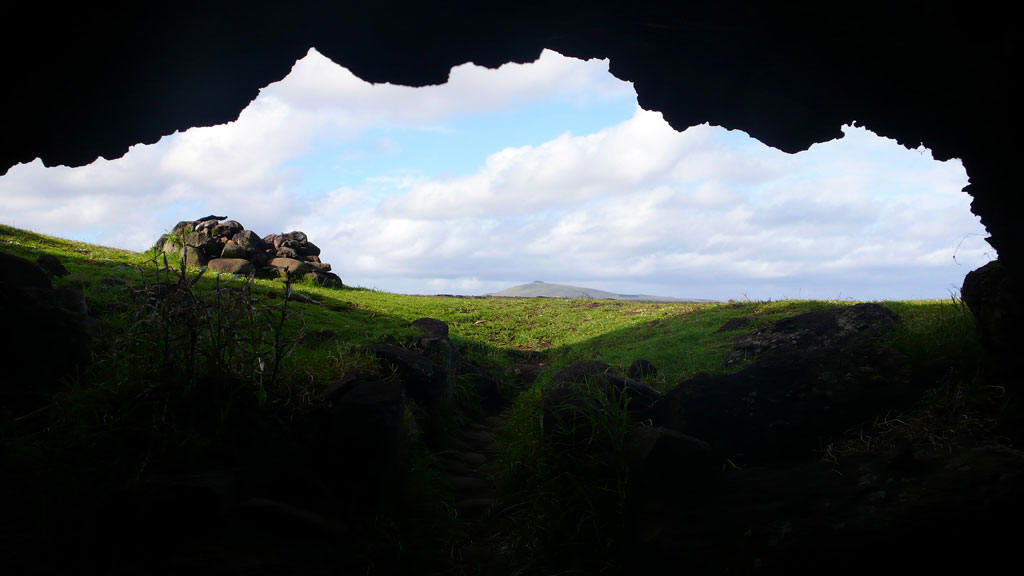|
|
Eruptive History at
Easter Island
 |
|
View from an Easter
Island lava tube13 |
Because there is no current activity at Easter Island,
nor has there been any since its inhabitation, work
regarding the eruptive past of this island hot spot is limited. There is a great deal of work
done, however, regarding the content/make up of Easter
Island's lava flows because this information has a
bearing on the island's famous statues and more
importantly on the evolution of the theory of hot spot
volcanism. From this work it is possible to
extract some information about the island's eruptive
history. Even if specific dates are hard to come by
then it is at least possible to see the general
progression of activity.
One can find materials at Easter ranging from basaltic
in composition to rhyolitic, though basalts are far more
common. It is also generally accepted that basalts
constitute the oldest deposits (~0.5 myr) and make up
the oldest volcanic feature, Poike, constituting the
island's eastern peninsula.8,
pg. 137
After activity at Poike began to
die down it appears to have shifted to Rano Kau, which
is located at the southwestern end of the island.
Activity here is said to have taken place until ~0.3 myr.
Part of the dating process for these features is done by
looking at the extent of soil formation and erosion by
the sea at each, which indicates Rano Kau was formed
between the earlier formation of Poike and the later
formation
of Terevaka.8,
pg. 138 The presence of the large
caldera that is the most noticeable feature of Rano Kau
obviously indicates that the land at this location
collapsed into the magma chamber below at some point in
the volcano's history.
Terevaka
This means of course that Terevaka is the youngest of
the three major volcanic formations. There is
evidence at Terevaka of both lava flows and pyroclastics.12,
pg. 120 The presence of
pyroclastics of course indicates
that during Easter's most recent eruptive past there has
been some at least minorly explosive activity (VEI 2
while previous activity was around 1). Rano Raruku,
the basaltic tuff cone from which the moai of the
island were carved, is another clue that there was some
mildly explosive activity because this is the only way
to explain the formation of tuff (consolidated ash).
This makes Rano Raruku a rare case in which low
viscosity basaltic lavas were present in a mildly
explosive eruption.
There is also a
mysterious formation separating the Poike Peninsula from
remainder of the island called the Poike ditch.
One theory suggests that "the ditch marks the
continuation of the ancient western coastline of what
would have been the island of Poike before it was joined
to the rest of Easter Island by lava from later
eruptions of the Terevaka volcano."10,
pg. 218 The lava
flow deposits east of the ditch seem to be smoother, presumably
from a longer period of weathering, than those on the
west, presumably originating at a later date from Terevaka. The theory goes on to assert that the
ditch itself could have resulted from seismic activity
after the fusion of the two islands when material fell
into a newly opened crack.10,
pg. 218
Most Recent Activity
Baker identifies the most recent
Easter Island activity as likely having taken place at
Maunga Hivahiva, a minor cone located midway between
Rano Kau and Terevaka along the western coast.
Here Baker found a flow abundant in lava tubes and with
an uneven surface and thin soils, all evidence of a
young viscous lava flow.12,
pg. 121 From Baker's analysis we
can make some assumptions about this activity. As
it originated from Maunga Hivahiva (a cinder cone),
there must have been some minor tephra involved, but the
lava flow rich in lava tubes also indicates that it was
predominantly effusive. The VEI for this eruption
was therefore likely 1.
|